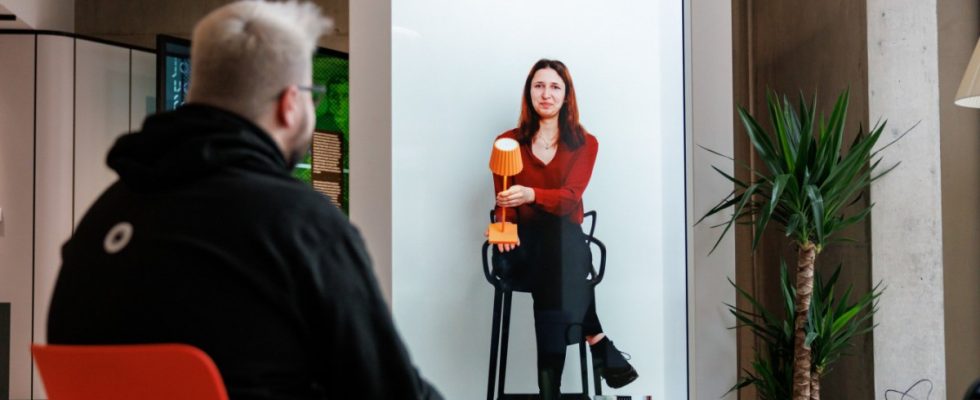Julie Singh’s work is currently reminiscent of “Star Trek”: as a hologram on a display, she advises people who are interested in designer lights or high-quality armchairs. Of course, it doesn’t look quite as lifelike as in the legendary science fiction series. To do this, Singh goes into a small studio in the corner of a furniture store in Nuremberg – and then appears as a three-dimensional image on a large display, in high resolution and in real time.
According to experts, what is an initial test could be a reality in retail in a few years. The furniture mail order company Cairo sees great potential in hologram technology. In addition to its online shop, the medium-sized company from Groß-Umstadt in Hesse has two branches in Frankfurt and Nuremberg, but would like to experiment with so-called pop-up stores, temporary shops, in other places. A major hurdle is the shortage of skilled workers, says board member Gero Furchheim. “What sets the stores apart is the experienced staff.” His idea is therefore to transfer sales consultants like Julie Singh to the temporary stores so that they can advise customers live and almost as if in a real conversation.
During the test project in Nuremberg, Singh’s hologram only has to travel 300 meters. Your image is transferred to a display in a nearby innovation lab, where test subjects can try out the new technology. They should then be asked about their experiences. Furchheim and his team want to find out, among other things, how holographic advice can best be implemented and how accepted it is by customers. The aim of the project, financed by the Günther Rid Foundation, is for other retailers to also benefit from the findings, says Furchheim.
But how realistic is it that holograms will soon take over sales conversations in stores? According to the Canadian manufacturer ARHT, for example, the technology is already being used at trade fairs and conferences. There are also initial advances in hologram telephony: using virtual reality glasses, it is possible to see three-dimensional holograms of the person you are talking to or of objects. Companies can already use the software from the Slovakian company Matsuko, which works with several network operators. But it will take a while before holograms appear in private phone calls. The Spanish telecommunications provider Telefónica with its German subsidiary O2 is aiming for a market launch in 2026.
In the near future, holograms will remain the exception in retail. “Hologram technology is currently more of a niche thing due to the costs,” says Martina Simon from the working group for services in the supply chain at the Fraunhofer Institute IIS in Nuremberg, which provides scientific support for the project in Nuremberg. “This is something you might encounter in five to 10 years, when the technology might have become a little more affordable.” In their opinion, this could also be helpful in medicine – the doctor, a medical hologram in “Star Trek”, sends his regards.
According to Furchheim, the hologram technology costs around 40,000 euros, plus around 10,000 euros for the studio’s equipment – something that a medium-sized company with 70 employees cannot manage. “We probably wouldn’t have done it without support,” says Furchheim. The trend for years has been to link digital and brick-and-mortar retail, explains Stefan Hertel from the German Retail Association. “The goal is for customers to then get the best of both worlds.”
Which target group should be addressed must first be clarified
Oliver Schmitz from the market research company NIQ/GfK also confirms that online is not a competition to the physical store, but rather complements it in many product range areas. Although online retail is growing very dynamically in many categories, the share of sales for everyday goods such as non-perishable food is still eight percent, and for technology and other durable consumer goods it is 35 percent. “It’s not an either/or. In the future, you’ll have to play on all channels in many markets,” says the expert.
From his point of view, however, a challenge will be which target group the retailers want to serve. “If you focus on everyone, you have to be careful that you don’t become a dealer for no one,” says Schmitz. The German Trade Association also emphasizes that the needs of customers are very different. “There are very technology-savvy customers who like to get involved in innovations. On the other hand, there are very stable people who would rather stick to the tried and tested,” says Hertel. That’s why, for example, there are checkouts where you can quickly scan purchases yourself and so-called chat checkouts where people can talk to each other.
The project in Nuremberg is also intended to answer the question of which people would like to be advised by a hologram seller. “So far the feedback has been enthusiastic,” says Furchheim. The test runs until March 17th. And will holograms soon be in use in Cairo? “In the summer we will talk about the results and discuss the next steps,” says Furchheim. But it is also clear that we will wait until there is more optimism and a better consumer mood in Germany.

